After 10 + 2 variants of taro (presumably referring to 10 + 2
months) had been brought onboard the Royal
Double Canoe, the time had come to 'all kinds of things', beginning
with a pair of great trees (Hauhau, Mahute) producing strings etc:
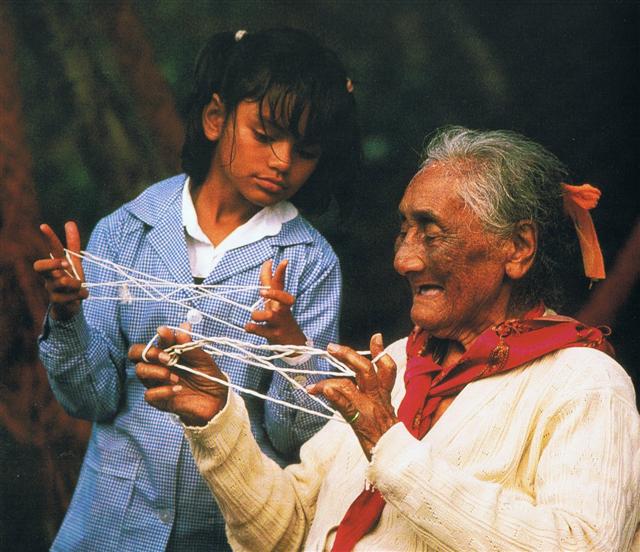
... Teke said to Oti, 'Go and take the hauhau tree, the paper
mulberry tree, rushes, tavari plants, uku koko grass, riku
ferns, ngaoho plants, the toromiro tree, hiki kioe plants (Cyperus
vegetus), the sandalwood tree, harahara plants, pua nakonako
plants, nehenehe ferns, hua taru grass, poporo plants, bottle
gourds (ipu ngutu), kohe plants, kavakava atua ferns,
fragrant tuere heu grass, tureme grass (Dichelachne sciurea),
matie grass, and the two kinds of cockroaches makere and
hata.' Oti and all his assistants went and took the
hauhau tree with them. All kinds of things [te huru o te mee]
(i.e., plants) and insects [?] were taken along ...
[E:69]
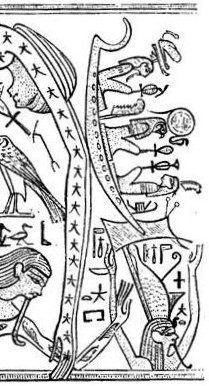
|
1 he
ti. |
1
he kape. |
|
Ti
by lying with Tattooing made the
ti plant (he ti ki ai ki roto
ki a he ta ka pu te ti). Burnt
ti leaves were used to
produce the black dye for tattooing.
... To
be in heat, to copulate, to embrace;
concupiscence, fornication,
impurity; lascivious, impure (ai)
...

Kape.
'Bitter-taro' (Alocasia
macrorrhiza). In 1957 kape
was still cultivated in much the
same way as dry taro. It is a type
of food to be eaten during times of
famine. According to Fuentes
(1960:856), the tubers had to be
kept in the earth-oven for 15 (sic)
days in order to eliminate some of
the poisonous components. Barthel
2. Arum, yam. Churchill.
Bitterness
by doing it with Bad-taste produced
the kape (mangeongeo ki ai
ki roto he rakerake ka pu te kape). |
|
APRIL 6 (96 = 3 * 32) |
7
(*17) |
 |
 |
|
Ga1-16 |
Ga1-17 |
|
Shur-narkabti-sha-iltanu-5 (Star in
the Bull towards the north)
σ
Aurigae (80.4),
BELLATRIX (Female Warrior)
=
γ
Orionis,
SAIF AL JABBAR (Sword of the Giant)
=
η
Orionis
(80.7),
ELNATH (The Butting One)
=
β
Tauri = γ Aurigae
(80.9)
*39.0 = *80.4 - *41.4 |
ψ
Orionis (81.1),
NIHAL (Thirst-slaking Camels)
=
β
Leporis
(81.7) |
 |
|
June 9 (*445 = *365 + *80) |
10 (161) |
|
... The month, which takes its name
from Juppiter the oak-god, begins on
June 10th and ends of July 7th.
Midway comes St. John's Day, June
24th, the day on which the oak-king
was sacrificially burned alive. The
Celtic year was divided into two
halves with the second half
beginning in July, apparently after
a seven-day wake, or funeral feast,
in the oak-king's honour
...
 |
|
°June 5 (156) |
6
(*77) |
|
'May 13 |
14 (*54) |
|
"April 29 (*39) |
Vaitu
Nui 30 |
|
CLOSE TO THE FULL MOON: |
|
OCT 6 (279 = 9 * 31) |
7
(*200) |
|
β, γ Arae (263.3), κ Arae (263.5), σ
Ophiuchi (263.6) |
LESATH (Sting)
=
υ
Scorpii,
δ
Arae (264.7),
CHOO (Club) =
α
Arae
(264.9) |
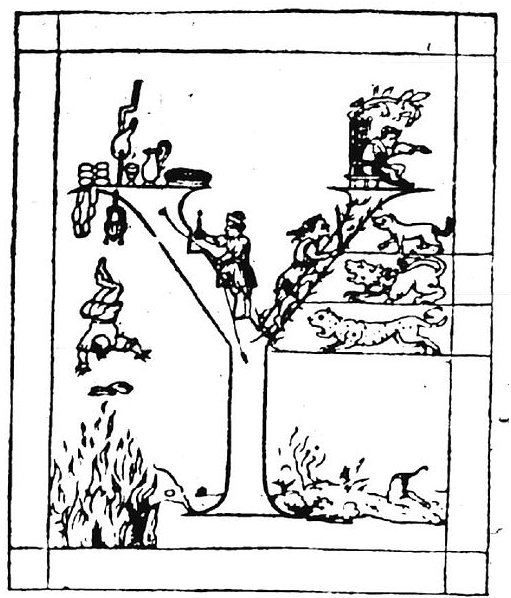
... For they say
that the course of human life
resembles the letter Y, because
every one of men, when he has
reached the threshold of early
youth, and has arrived at the place
'where the way divides itself into
two parts', is in doubt, and
hesitates, and does not know to
which side he should rather turn
himself“...


 |
|
Dec 9 (343 = 7 * 49 = 279 + 8 * 8) |
10 (161 + 183) |
|
°Dec 5 (339) |
6
(*260) |
|
'Nov 12 (*236 = 8 * 29½) |
13 (317 = 161 + 12 * 13) |
|
"Oct 29 (*222) |
Tangaroa Uri
30 |
|
... Page E:86 tells about
Makoi being left behind on
Easter Island when the remaining
5 Explorers sailed home to
Hiva. From there (Tangaroa
Uri 25) to the day when Hotu
became worried about where Oto Uta was,
i.e. in Tangaroa Uri 30,
there were 5 days:
|
April
25 (115) |
5
+ 56 |
June
25 (176) |
5 +
116 |
Oct
25 (298) |
5
+ 56 |
Dec
25 (359) |
5 +
116 |
|
61 |
2 *
61 |
61 |
2 *
61 |
|
183 |
183 |
|
366 =
2 * 183 = 6 * 61 |
And from the autumn equinox
(265) at Antares to the Sting of
the Scorpion (υ
Scorpii) there were 15 days
...

... the tubers
[of kape] had to be kept in the earth-oven for
15 (sic) days in order to
eliminate some of the poisonous
components ... |
Hau
= Thread, line, string, ribbon; this is the name
of the fibres of the hauhau tree formerly
used to make twine, cloth, etc.; hau kahi,
fishing line for tuna; hau here, line for
eel trap; hau moroki, strong, tough line,
thread; hau paka, fibres of the hauhau
tree, which were first soaked in water, then
dried to produce a strong thread. Ha'u =
Hat. Vanaga. Hat, cord; the tree Triumfetta
semitriloba. Van Tilburg. Ta.: The tree
Hibiscus tiliaceus. Henry. Hau. 1 a.
Hibiscus. b. Wick. P Pau.: fau, hibiscus.
Mgv.: hau, id. Mq.: fau, hau,
id. Ta.: fau, id. 2. To contribute. Ta.:
aufau, to pay, to contribute, to
subscribe. 3. Hat, cap, helmet; hakarere ki
te hau, to take off the hat. Ta.:
fauurumaa, war bonnet. 4. Dew;
hakaritorito ki te hau, to bleach in the
dew. P Mgv., Mq.,Ta.: hau, dew. 5. To
blow freshly, coolness, zephyr, salubrious,
breeze, wind (hahau, ahau);
kona hauhau, kona hahau, a breezy
spot; ahau ora, agreeable breeze;
hakahahau, to hang out in the air;
hakaahau, to blow. T Mgv.: hau, to
blow, blusterous, to breathe. Haua,
hoarse. (Hauha); araha hauha, to
wait for, to look forward to. Hauhau, 1.
dog (onomatopoetic). 2 a. To scratch, to scrape,
to rub. b. Wood used in plowing fire. 3. (hau
5). Haumaru (hau 5 -
marumaru) cool, cold. Hauł, to
replace. Hauva, twin, cut T. Hauvaero
(hau 3 - vaero) plume, aigrette,
head ornament. Hauvarikapau (hau 3
- varikapau) plume, aigrette, head
ornament. Churchill. Pau.: Hau, superior,
kingdom, to rule. Mgv.: hau, respect.
Ta.: hau, government. Mq.: hau,
id. Sa.: sauā, despotic. Ma.: hau,
superior. Hauhau, to attack. Ma.: hau,
to chop. Churchill. Sa.: fau, to tie
together, to fasten by tying, the tree (Hibiscus
tiliaceus) whose bast is used for cord, the
kava strainer made therefrom, strings in various
uses; fafau, to lash on, to fasten with
sennit; faufau, to fasten on, to tie
together. To.: fau, to fasten up the
hair, the name of the hibiscus, the kava
strainer made therefrom; faufau, to
fasten the outriggers of small canoes; hau,
to fasten to; fehauaki, to tie. Fu.:
fau, the hibiscus, the kava strainer; fał,
fafał, fałfał, to attach, to tie.
Niuē: fau, fafau, to make by
tying. Fotuna: no-fausia, to tie, to
fasten. Ta.: fau, the hibiscus; fafau,
to tie together. Pau.: fau, the hibiscus.
Nuguria: hau, id. Ma.: hau, to
bind, to fasten together; whau, a shrub;
whauwhau, to tie. Ha.: hau, name
of a tree with a practicable bark. Mq.: hau,
the hibiscus. Mgv.: hau, id.; hahau,
to join or tie with cords. Nukuoro: hau,
the hibiscus, a garland. Mg.: au, the
hibiscus. Vi.: vau, the hibiscus;
vautha, to bind together. Churchill 2.
Mahute. A
tree (Boussonetia papyrifera) formerly more abundant on
the island, the fibres of which were used for clothing (see
nua and hami).
Vanaga. The tree Broussonetia
papyrifera, indispensible for all types of fasteners (lines,
twine, ropes, and rigging). Barthel 2. Maute,
paper mulberry (mahute G). P Mgv.: eute, ute,
id. Mq.: ute, id. Ta.: aute,
Hibiscus rosa-sinensis. Pau.: aute, id. Mahutehute
(mahute - tutu 1) bast cloth in the last stage of
preparation (maute). Churchill.
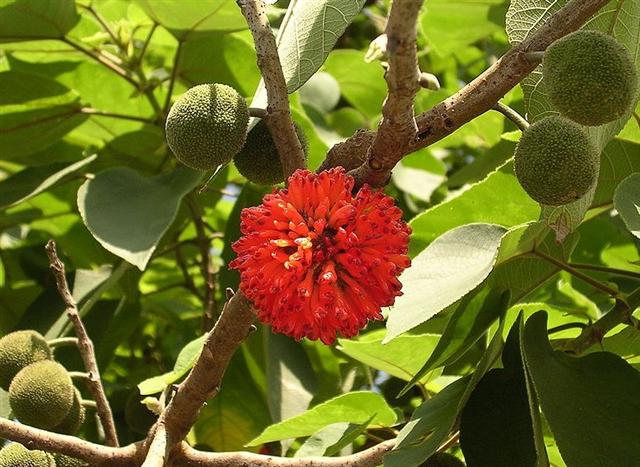
|
1 he hauhau. |
1 he mahute. |
1 he ngaatu |
|
Gaatu, totora reed. Vanaga.
Gaatu 1. Bulrush, reed. 2.
(gatu). Churchill.Gatu. Gaatu, totora
reed. Gatu: 1. To press, to tighten, to
squeeze. 2. To pack tight. 3. To pull suddenly, to
give a jerk. I ka hakarogo atu, ku eke į te kahi,
he gatu mai, as soon as he felt the tuna be, he
pulled in [the line] with a sharp jerk. 4. To kick.
5. E gatu te hagu, to wait for something
impatiently (gatu, breath). 6. Shortly, very
soon. He tu'u gatu, he is coming shortly, he
is just about to arrive. Vanaga. Bulrush, reed.
Gaatu (gatu) 1. To feel of, to pinch, to
throttle with the hands, to touch, to press (gaatu);
gatuga, pressure; gatugatu, to trample
down. T Mgv.: natu, to press out linen, to
squeeze a person or a sore place. Mq.: natu,
to pinch. Ta.: natu, to pinch, to bruise. 2.
To suppurate. 3. Gatu mai gatu atu, sodomy.
Gatua (gatu 1), tractable, to press.
Churchill. Scirpus riparius var.
paschalis. Barthel 2.
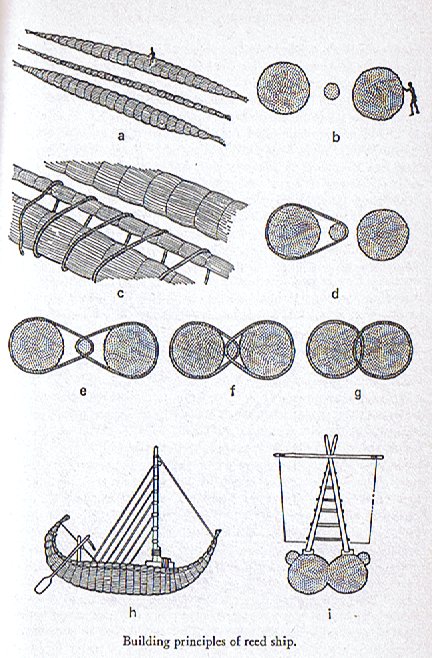
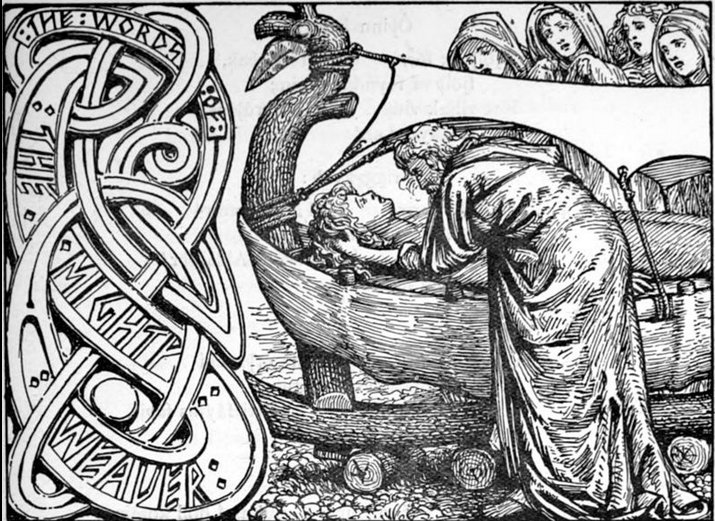
... All this,
which in so many ways parallels the normal imagery
of the Old World culture-hero myths, telling of the
one who is gone, dwells underground in a happy,
timeless land, as lord of the realm of the happy
dead, like Osiris, but will rise again, we
can read without surprise.
But what is surprising indeed was the manner of
Quetzalcoatl's actual return. The priests and
astrologers did not know in what cycle he was to
reappear; however, the name of the year within the
cycle had been predicted, of old, by Quetzalcoatl
himself. Its sign was 'One Reed' (Ce Acatl),
which, in the Mexican calendar, is a year that
occurs only once in every cycle of fifty-two. But
the year when Cortes arrived, with his company of
fair-faced companions and his standard, the cross,
was precisely the year 'One Reed'. The myth of the
dead and resurrected god had circumnavigated the
globe ...
|
1 |
Cipactli (alligator) |
11 |
Ozomatli (monkey) |
|
2 |
Ehecatl (wind) |
12 |
Malinalli (grass) |
|
3 |
Calli (house) |
13 |
Acatl (reed) |
|
4 |
Cuetzpallin (lizard) |
14 |
Ocelotl (jaguar) |
|
5 |
Coatl (serpent) |
15 |
Cuauhtli (eagle) |
|
6 |
Miquitztli (death) |
16 |
Coz-cacuauhtli (buzzard) |
|
7 |
Mazatl (deer) |
17 |
Ollin (movement) |
|
8 |
Tochtli (rabbit) |
18 |
Tecpatl (flint knife) |
|
9 |
Atl (water) |
19 |
Quiahuitl (rain) |
|
10 |
Itzcuintli (dog) |
20 |
Xochitl (flower) |
|
20 * 13 = 260 and 13 * 13 = 169 = 260 -
91.
 |
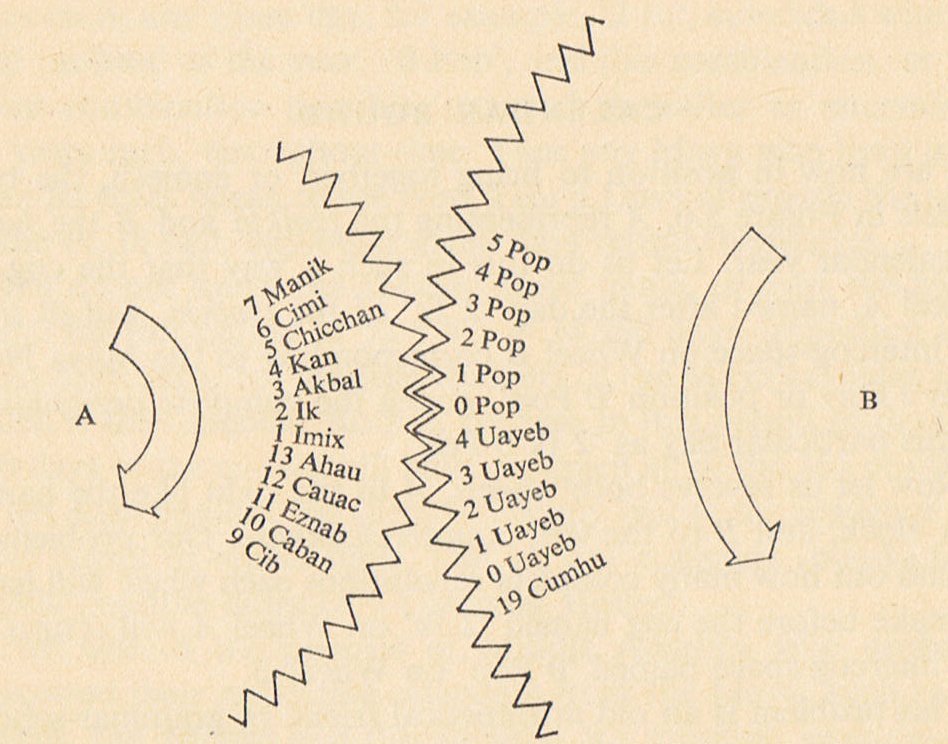
|
|
APRIL 8 |
9 (*19) |
10 (100 = 88 + 12) |
 |
 |
 |
|
Ga1-18 |
Ga1-19 |
Ga1-20 |
|
KHUFU
MINTAKA (Belt)
=
δ
Orionis,
υ
Orionis (82.4),
χ
Aurigae (82.5),
ε
Columbae (82.6)
*41 = *82.4 - *41.4 |
KHAFRE
Al Hak'ah-3 (Brand) /
Mrigashīrsha-5 (Stag's Head) /
Turtle Head-20 (Monkey) /
Mas-tab-ba-tur-tur (Little Twins)
ARNEB =
α Leporis, Crab Nebula = M1 Tauri
(83.0,
φ¹
Orionis (83.1),
HEKA
= λ Orionis,
ORION
NEBULA
= M42
(83.2),
φ²
Orionis (83.6),
ALNILAM (String of
Pearls)
= ε Orionis
(83.7) |
MENKAURE
Three Stars-21 (Gibbon) /
Shur-narkabti-sha-shūtū-6 (Star in the Bull towards
the south)
/ ANA-IVA-9 (Pillar of
exit)
HEAVENLY GATE
= ζ Tauri,
ν
Columbae (84.0),
ω
Orionis (84.2),
ALNITAK (Girdle)
= ζ Orionis,
PHAKT (Phaet)
= α Columbae
(84.7) |
|
June 11 |
12 (163 = 136 +
27 = 263 - 100) |
13 (*84) |
|
°June 7 |
8 |
9 (*80) |
|
'May 15 (365 +
135 = 500) |
16 (136 = 8 * 29½
- 100) |
17 (*57) |
|
The Julian calendar had been 10 days ahead at the
time when Gregory XIII launched his new calendar and
then 2 more (days ahead) would have to be subtracted
if the change from the Julian to the Gregorian
calendar had happened later, when the King of Spain took
command over Easter Island in 20 November (324) AD
1770. Which means 10 + 2 number of
taro varieties could have referred not only to a
change in the number of months but also to number of
days needed to add in order to return from the Gregorian
to the Julian dates.
|
|
"May 1 (121 = 11
* 11) |
2 |
3 (*43) |
|
... the real
surprise revealed by Bauval's astronomical
calculations was this: despite the fact that some
aspects of the Great Pyramid did relate
astronomically to the Pyramid Age, the Giza
monuments as a whole were so arranged as to provide
a picture of the skies (which alter their appearance
down the ages as a result of the precession of the
equinoxes) not as they had looked in the Fourth
Dynasty around 2500 BC, but as they had looked - and
only as they had looked - around the year
10,450 BC ...

.jpg) |
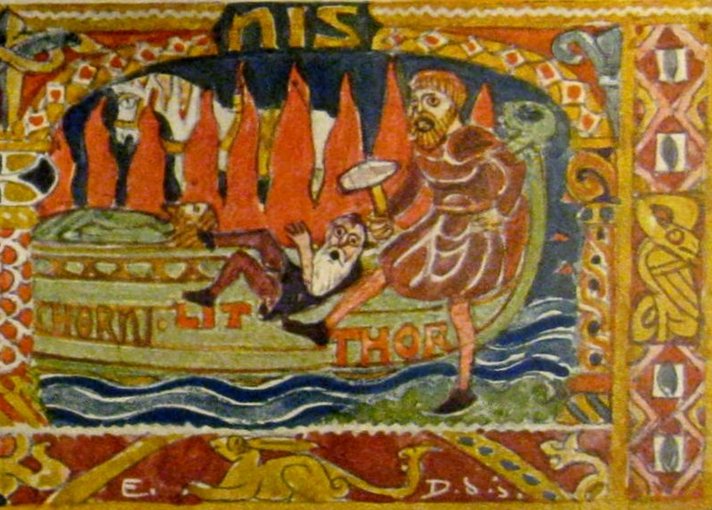
|

















.jpg)

.jpg)
